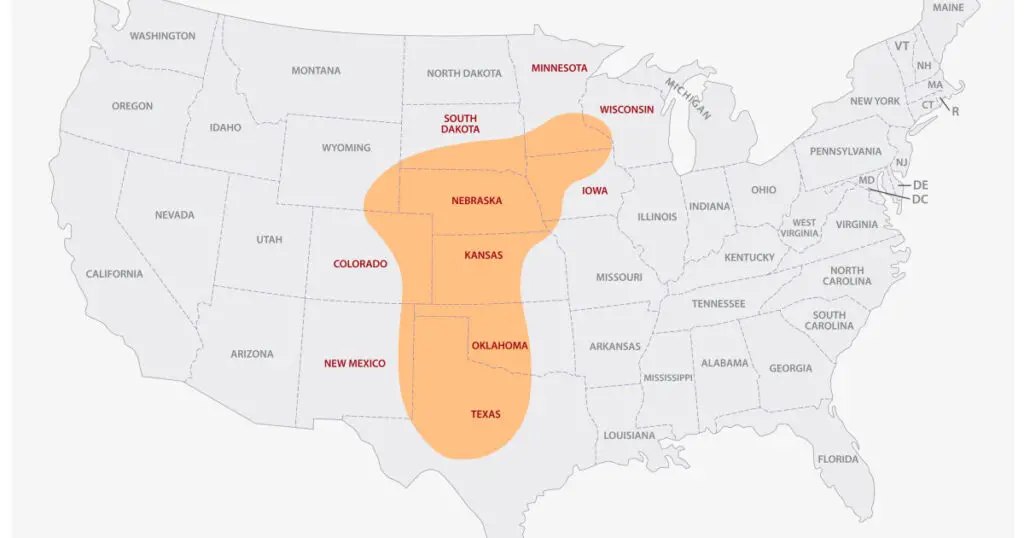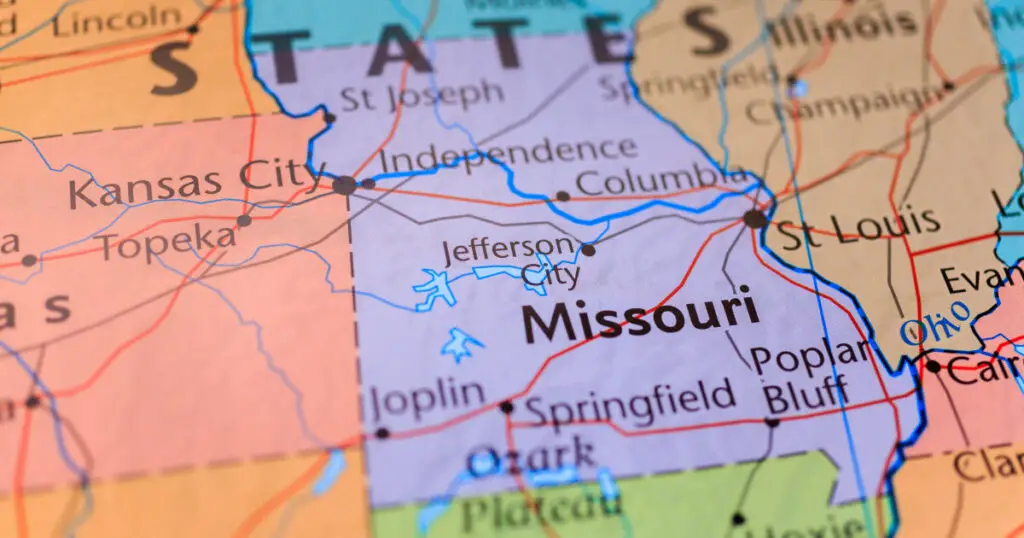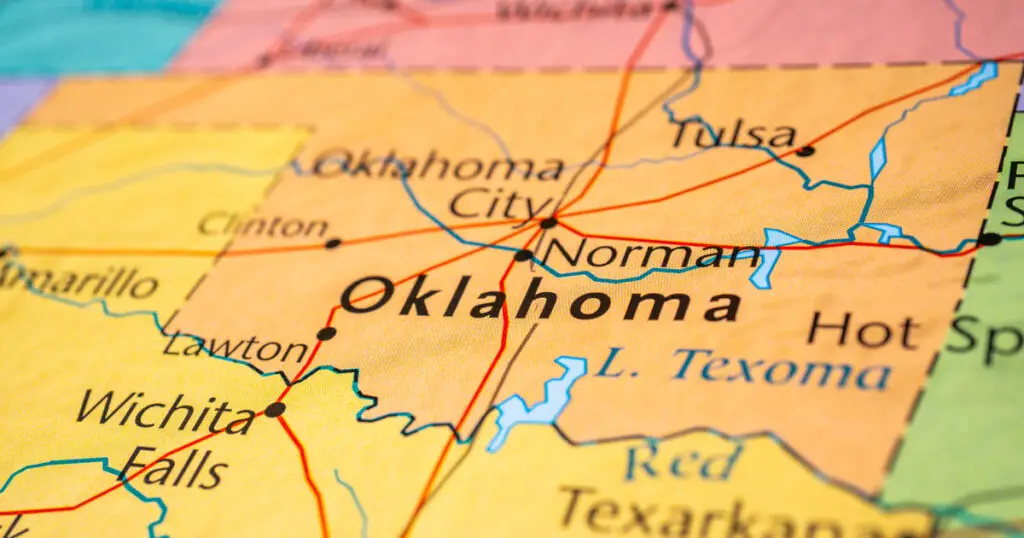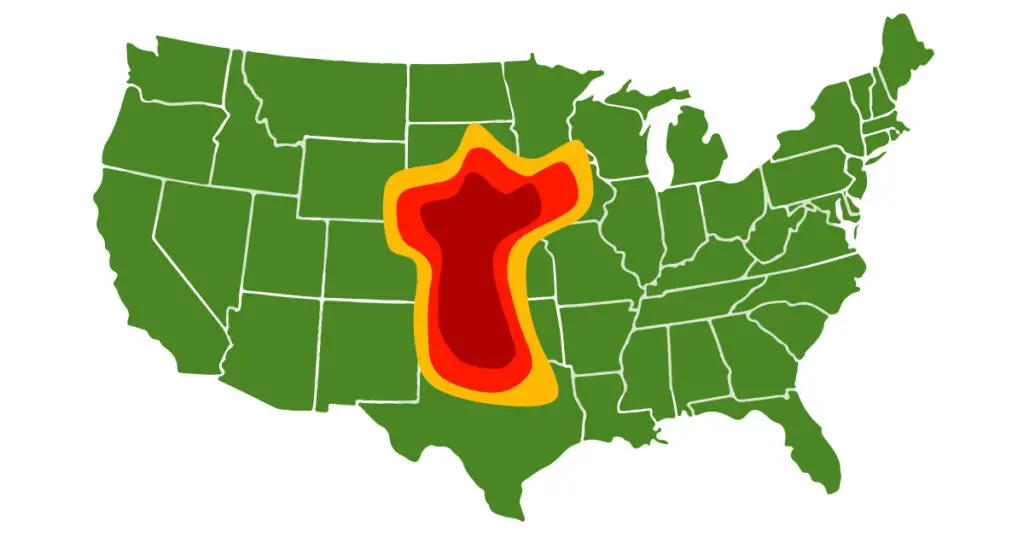American citizens understand the cataclysmic effects of tornadoes. The United States annually experiences many devastating storms, and the most tornadoes per nation. The region across the US Midwest, known as “Tornado Alley” is particularly prone to tornadoes due to its weather and geographical characteristics. What states are in tornado alley, and how many tornadoes occur there each year?
In this article, we’ll go over how far tornado alley stretches, including which states it includes. We’ll also cover what about this area makes it so prone to these devastating storms.
The States of Tornado Alley
There are no clear boundaries marking the territory of Tornado Alley, however the following states are considered to make up the bulk of tornado alley in the US:
- Texas
- Oklahoma
- Nebraska
- Kansas
- Colorado
- South Dakota
Which US State has the Most Tornadoes per Year?
Texas currently holds the record for the most Tornadoes recorded annually, with an average of 155 per year.
What are Tornadoes?
While tornadoes and the destruction they cause may be a familiar sight, many are unaware of what they are exactly
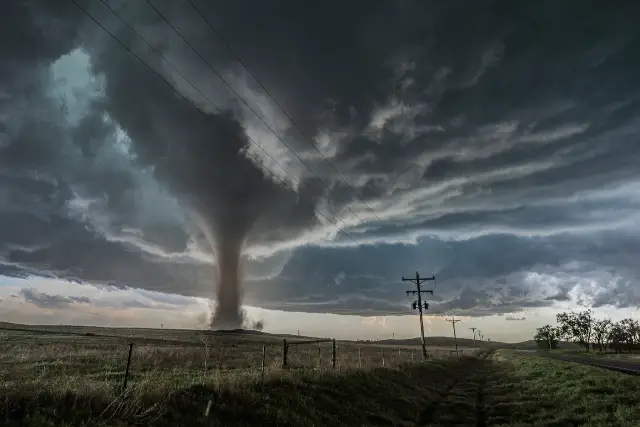
A tornado is a fierce, highly turbulent pillar of air, moving rapidly while maintaining contact with the earth’s surface. It carries compressed water vapors known as cumulonimbus clouds. Tornadoes are created from the exceptionally large thunderstorms known as supercells.
The bottom of the tornado vortex is engulfed by gathered-up dust and debris, which is what causes the frequently visible grey color. Tornadoes often appear in a funnel-like shape, however, the exact shape and assembly can differ in accordance with the climate.
Tornadoes can be catastrophic. Their speed ranges from 110mph to 300mph. They can last for up to 4 hours and, in the most extreme cases, reach a height of 75 feet.
Tornadoes also occur in parts of Asia and South America. They’ve also occurred in Australia and parts of Eastern Europe.
While Tornado Alley is most partial to these natural disasters, they can occur anywhere that has the proper conditions.
What Causes Tornadoes?
Tornadoes are essentially caused by tempestuous winds. Wind shear is the most integral component of tornado formation.
Wind shear refers to the change in direction and wind speed. These rapid changes create a spinning motion within the storm cell. The spinning air rushing up collides with the spinning air rushing down to form the classic, funnel shaped cloud of tornadoes.
Usually, these winds combine in conditions where warm, humid air meets cooler, dry air. The different air properties results in an unstable atmosphere which in turn causes the wind to alter direction, increase speed, rise up, and begin to rotate.
The most destructive tornadoes emerge from existing thunderstorms that already have violent winds in rotation. Only about one in a thousand storms will lead to a tornado.
| Related Posts |
|---|
Why do Tornadoes Occur in Central States?
While tornadoes can arise in various places across the globe, they occur most commonly in the United States. Indeed, the United States records more cases of tornados annually than any other country with the vast majority occurring in Tornado Alley.
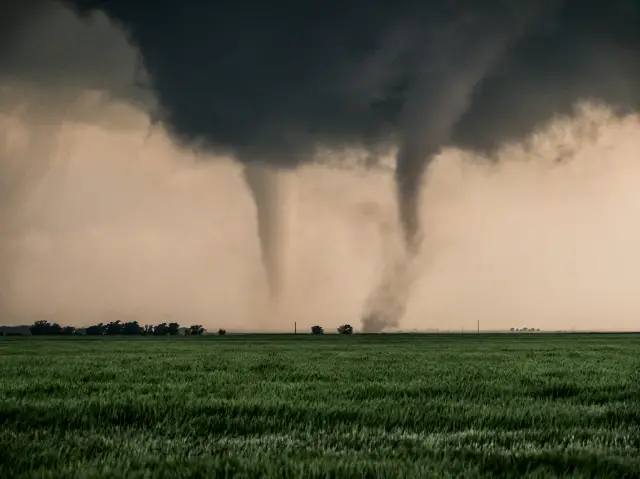
This area doesn’t just have the highest number of tornadoes, either. The most powerful tornadoes frequently occur here, as well. But why is this case?
Tornadoes are so recurrent in this area because the moist, warm air traveling north from the Gulf of Mexico collides with the cool, dry Canadian air traveling south. This provides the perfect climatic conditions for tornadoes.
Tornado Season
While tornadoes can occur at any time of year, they tend to arise more during the spring for the “Tornado Alley” region. This is in accordance with the jet stream of the Gulf of Mexico. May has more tornadoes than other months, although April and June get these powerful, violent twisters too.
Further north, tornadoes are more likely to occur later in the summer, during the hotter, wetter seasons in those areas.
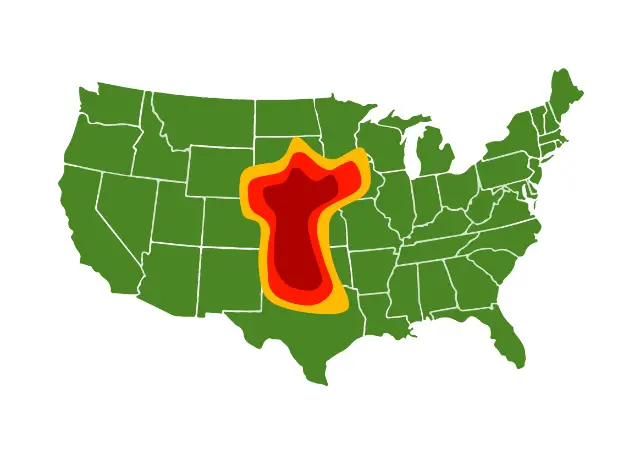
Seasonal Data For Each Tornado Alley State
In this table you’ll find the average number of tornadoes each tornado alley state experiences each year. You’ll also find the months of each state’s peak tornado season.
| State | Average Annual No. of Tornadoes | Tornado Season |
| Texas | 155 | May to June |
| Kansas | 96 | Mid-April to Mid-June |
| Oklahoma | 62 | Mid-April to June |
| Nebraska | 57 | May to June |
| Colorado | 53 | May to June |
| South Dakota | 36 | May to June |
Tornadoes can occur at any point during the day or night. However, they are far more likely to form during the afternoon. This is because the sun has had time to heat the ground and atmosphere. The new heat introduces an adequate amount of humidity to form thunderstorms.
How is Tornado Strength Rated?
Tornado’s strength is rated from 0 to 5, calculated according to the damage the tornado caused. It is known as the Enhanced Fujita Scale (EF).
This scale, originally known as just the Fujita Scale (F) is named after Dr. Ted Fujita, the system’s creator. In 2007, the Enhanced Fujita Scale was refined by a collection of meteorologists and wind engineers in order to improve the estimation of wind speed and how fast the tornado was spinning.
The EF is more accurate insofar as it incorporated more variables and specifically looks at damage indicators, such as tree collapses. The indicators are all assessed on the degree of damage, from some visible damage to complete destruction.
After a storm has passed, the National Weather Service (NWS) sends out meteorologists to conduct surveys and assess the tornado’s impact, including deaths and human injury.
Small, low-impact tornadoes are not always investigated by the National Weather Service. Instead other evidence such as photographs are used to estimate the EF rating.
The average time it takes to carry out a survey following a tornado and estimate the EF rating is 1-2 days.
Warning Signs a Tornado Will Occur
While it is impossible to accurately predict the arrival of a tornado, there are a few signs which may mark the near arrival of one.
- A somber, green-tinted sky
- A looming cloud of debris
- Large hailstones with no rain
- A sudden stillness following strong winds
- An audible roar of wind, like the sound of a train engine
Despite huge leaps forwards in meteorological study, there are still many variables that make it difficult to predict tornadoes.
What to Do During a Tornado
The 2019 tornado season in the United States killed 41 people and injured countless more. If you live in a region affected by frequent tornadoes, it’s a good idea to be prepared and know how best to act in order to stay safe.
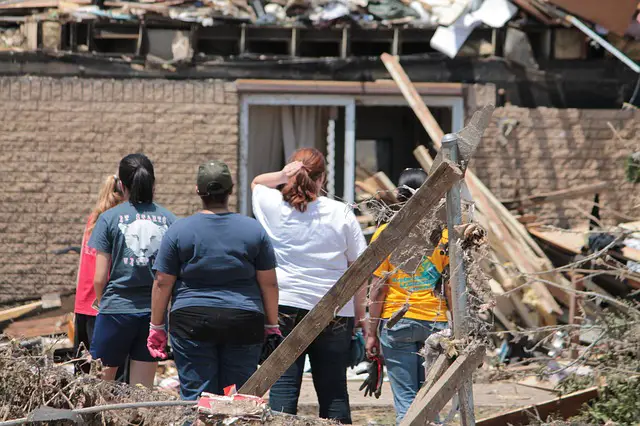
The first and potentially most important step is to plan and prepare in advance of a tornado. You can know when to do this by keeping a keen eye on meteorological reports and taking extra steps during peak tornado season.
The National Oceanic and Atmospheric Agency (NOAA) states there is no way to guarantee full safety during a tornado storm. Even a slight chance of a tornado must be treated as a serious matter. While some tornadoes can be violent enough to destroy houses, these EF-5 storms are very uncommon. Most tornadoes are significantly less powerful.
You are therefore very likely to survive a tornado, provided you follow certain safety precautions. Here are some important guidelines on how to stay safe during a tornado.
Preparation
- Formulate a tornado plan, including where you and your family will take shelter, i.e. in the cellar.
- Make sure you have access to a television or radio during a tornado so that you can keep up to date with emergency weather information, including when it is safe to come out. You can keep this in your cellar or place of shelter.
- A kit of emergency goods, including food (non-perishable, like canned goods), water, any medication you require, batteries.
- Keep a list of important information, like emergency numbers and contact information of loved ones.
- Educate your children on how to behave in a tornado and where to shelter. Make sure they know what region they live in and can identify whether their location is at risk of a tornado.
Keep up to date with weather conditions
Make sure you keep an eye on the changing weather conditions of your location. If you know that thunderstorms are expected, keep up to date with the weather announcements, and look out for any signs that a tornado might be approaching (see above, ‘Warning Signs a Tornado will occur’)
Shelter
The majority of deaths during a tornado are caused by falling objects and debris. While there is no location completely safe during a tornado, some places offer more protection than others.
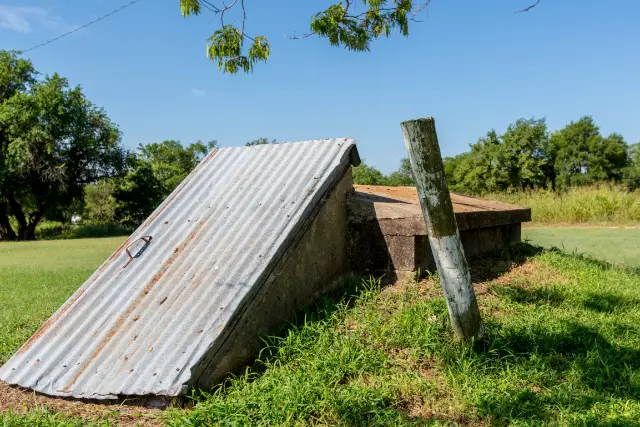
- Find a cellar or a room without windows on the lowest floor, such as a closet room or bathroom.
- Avoid windows as the glass can shatter and cause injury.
- Try to get beneath a sturdy object, such as a desk or table.
- Cover yourself with a blanket or mattress, or anything protective you can find, like coats and jackets.
- Avoid mobile homes – most tornado deaths occur in mobile homes.
- If you are in a car or a mobile home, try to get to the nearest building to shelter in the basement there.
- If you are inside a car, do not attempt to outrun a tornado. Instead, try to access the nearest building.
No one can predict how strong a tornado will be before it arrives. If you find yourself in one of the “Tornado Alley” states, make sure you pay close attention to your local weather information and stay safe.
